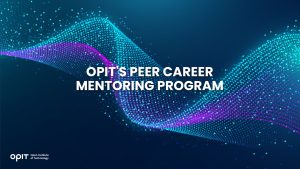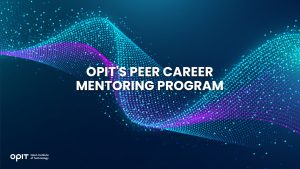

At the Open Institute of Technology (OPIT), we have a simple goal – to provide high-quality yet accessible education in the technology field. But for our courses to be high-quality, the professors behind them must be equally exceptional.
And they absolutely are.
The OPIT professors are paragons of expertise and passion. Each professor has been handpicked for their profound understanding of technology, coupled with extensive academic achievements and industry experience. That’s why these architects of knowledge bring both theoretical depth and real-world insights into every class at OPIT.
So, what better way to get to know our world-class OPIT faculty than to hear their thoughts on the topics they’re passionate about? In this article, you’ll read what five of our top-notch faculty members have to say about tech innovations transforming the world. Of course, you’ll also get a quick overview of other members of our inspiring faculty shaping the next generation of leaders in technology and digital space.
The OPIT Faculty at a Glance
Before diving into our faculty members’ fascinating biographies and insights, let’s take a moment to appreciate the diverse expertise that forms the backbone of OPIT.
Our faculty is a mosaic of over 30 accomplished professionals from all over the world, each bringing a unique perspective to the table.
And that’s the beauty of online learning. How else would you be able to connect with experts spanning the globe, all from the comfort of your own home?
Our inspiring faculty comes from over 15 countries and four continents. The U.S., Canada, Brazil, Lebanon, Germany, France, India and Italy are just some of the nations represented. This collage of diverse backgrounds (and experiences) ensures that your education at OPIT transcends geographical boundaries, offering a truly global perspective on technology.
Meet the OPIT Faculty at the Forefront of Technology
Now that you have a better idea of the diverse expertise within our faculty, let’s introduce you to the brilliant minds at the forefront of technology education at OPIT. This time, we asked five of our esteemed faculty members how recent tech innovations have transformed the world. Here are their answers.
Raj Dasgupta, Ph.D.
Professor Raj Dasgupta is an impressive individual in every regard. He’s currently a research scientist at the U.S. Naval Research Laboratory after teaching computer science for almost 18 years at the University of Nebraska. His research projects have been funded by the U.S. Department of Defense and NASA, and he has earned a Ph.D. in Computer Engineering from the University of California. Talk about a multifaceted professional!
At OPIT, Professor Dasgupta teaches Data Structures and Algorithms, Reinforcement Learning, and Introduction to Artificial Intelligence in the Bachelor of Science in Modern Computer Science program. The last subject is also a part of the Bachelor of Science in Digital Business program. He also teaches Machine Learning in the Responsible Artificial Intelligence program.
When asked about the transformative impact of tech innovations, Professor Dasgupta singled out the brain-computer interface (BCI) system as the technology that fascinates him the most. He explains, “We have been able to link the human thought, the human brain, with these assistive devices.” This connection means that these BCI systems can extract (and use) any thoughts from people who can’t speak for themselves or express their thoughts. As Professor Dasgupta puts it, all it takes is for them to “just think what they want to do.”
Santhosh Suresh, Ph.D.
With giants like PayPal, Meta, and McKinsey & Company on his resume at a young age, it’s evident that Professor Santhosh Suresh possesses remarkable expertise in business problem-solving. Business Problem Solving is precisely the subject he teaches at OPIT’s Master of Science in Applied Data Science & AI and Applied Digital Business programs.
So, it’s no wonder his answer to our question also focuses on solving problems, this time with technology. He rejoices at the fact that the ultimate knowledge is no longer reserved only for the rich and privileged. Thanks to advanced data science-based algorithms, “the efficiency of airlines or railroads or how we do operations in the surgery room has gone up exponentially, and that is improving the quality of lives of millions if not billions of people.”
Paco Awissi, MBA
A data science leader. An analytics expert. A machine learning practitioner. These are just some of the impressive attributes that define Professor Paco Awissi’s career. These flattering attributes also landed him the coveted positions of Vice President of Data and Reporting at Morgan Stanley, Lead Instructor at McGill University School of Continuing Studies, and, of course, Professor at OPIT.
Professor Awissi teaches three courses in our Master of Science in Applied Data Science & AI program – Project Management, Applications in Data Science and Artificial Intelligence (Part 2), and Business Communication.
When asked about new tech advancements, he also focuses on AI, explaining that the technology is revolutionizing “risk management, fraud detection, and personalized financial services.” Professor Awissi adds that AI is also used in “algorithmic trading, credit scoring, and automating customer service through chatbots, which improves the efficiency and inclusiveness of financial services.”
Filip Biały, Ph.D.
Professor Filip Biały comes from Poland, where he has taught at the Adam Mickiewicz University in Poznan for over 15 years. When it comes to Professor Biały, it’s hard to tell whether he has more education or experience in computer science and artificial intelligence.
However, his main goal is to understand the consequences of AI for democratic politics, which is why he also emphasizes that the negative impact of digital technologies shouldn’t be overlooked. As for the positive sides of this life-changing technology, Professor Biały says that it is “essential in improving the efficiency of business processes and advancing research, for example, in discovering new drugs.”
At OPIT, you can listen to Professor Biały’s fascinating insights in the Bachelor of Science in Modern Computer Science and Digital Business programs (ICT Fundamentals, Web Development, and Ethics of Computer Science & AI courses).
Tom Vazdar, Ph.D.
Like his colleague, Professor Tom Vazdar also primarily focuses on the negative implications of technological advancements. As a current AI and Cybersecurity Strategist of a boutique consulting firm and the former Chief Security Officer at Erste Bank Croatia, he knows just how important cybersecurity is and how dangerous technological progress can be without adequate safeguards.
That’s why he’s the expert OPIT put in charge of its latest Master of Science program – Enterprise Security. OPIT has worked closely with Professor Vazdar to develop this program and equip students with the most in-demand technical, managerial, and soft skills.
Professor Vazdar also teaches Introduction to Computer Security in the Modern Computer Science and Digital Business programs, as well as Behavioral Cybersecurity in the abovementioned Enterprise
Security program.
Meet More OPIT Faculty Members Helping You Succeed
If you apply to OPIT, you’ll get the unique chance to learn from the very best from all over the world. But until then, you can hear more intriguing perspectives from our faculty members. Visit the Faculty section of our website to get a sneak peek of the incredible expertise and global perspectives that shape OPIT.
The professors at OPIT have either taught at prestigious universities or have a long and impressive history in the industry. For the former, our professor’s biographies are adorned with institutions like the University of Copenhagen, the University of Rome, the Italian Institute of Technology, and the University of Stuttgart.
As for the latter, Microsoft, Meta, Symantec, and UBS are just some of the world-famous companies where our faculty members have left a lasting impact. The same goes for institutions like the Europol, the European Parliament, and the European Investment Bank (EIB).
Though our faculty members come from different corners of the world, they all share a common goal – a relentless pursuit of knowledge. By learning from these top-notch professionals, you’ll get an insight into decades of cutting-edge research, industry collaboration, and real-world experience. This knowledge and the skills you acquire at OPIT will help you play a leading role in the technological revolution, just like your professors.
Related posts

Source:
- Raconteur, published on November 06th, 2025
Many firms have conducted successful Artificial Intelligence (AI) pilot projects, but scaling them across departments and workflows remains a challenge. Inference costs, data silos, talent gaps and poor alignment with business strategy are just some of the issues that leave organisations trapped in pilot purgatory. This inability to scale successful experiments means AI’s potential for improving enterprise efficiency, decision-making and innovation isn’t fully realised. So what’s the solution?
Although it’s not a magic bullet, an AI operating model is really the foundation for scaling pilot projects up to enterprise-wide deployments. Essentially it’s a structured framework that defines how the organisation develops, deploys and governs AI. By bringing together infrastructure, data, people, and governance in a flexible and secure way, it ensures that AI delivers value at scale while remaining ethical and compliant.
“A successful AI proof-of-concept is like building a single race car that can go fast,” says Professor Yu Xiong, chair of business analytics at the UK-based Surrey Business School. “An efficient AI technology operations model, however, is the entire system – the processes, tools, and team structures – for continuously manufacturing, maintaining, and safely operating an entire fleet of cars.”
But while the importance of this framework is clear, how should enterprises establish and embed it?
“It begins with a clear strategy that defines objectives, desired outcomes, and measurable success criteria, such as model performance, bias detection, and regulatory compliance metrics,” says Professor Azadeh Haratiannezhadi, co-founder of generative AI company Taktify and professor of generative AI in cybersecurity at OPIT – the Open Institute of Technology.
Platforms, tools and MLOps pipelines that enable models to be deployed, monitored and scaled in a safe and efficient way are also essential in practical terms.
“Tools and infrastructure must also be selected with transparency, cost, and governance in mind,” says Efrain Ruh, continental chief technology officer for Europe at Digitate. “Crucially, organisations need to continuously monitor the evolving AI landscape and adapt their models to new capabilities and market offerings.”
An open approach
The most effective AI operating models are also founded on openness, interoperability and modularity. Open source platforms and tools provide greater control over data, deployment environments and costs, for example. These characteristics can help enterprises to avoid vendor lock-in, successfully align AI to business culture and values, and embed it safely into cross-department workflows.
“Modularity and platformisation…avoids building isolated ‘silos’ for each project,” explains professor Xiong. “Instead, it provides a shared, reusable ‘AI platform’ that integrates toolchains for data preparation, model training, deployment, monitoring, and retraining. This drastically improves efficiency and reduces the cost of redundant work.”
A strong data strategy is equally vital for ensuring high-quality performance and reducing bias. Ideally, the AI operating model should be cloud and LLM agnostic too.
“This allows organisations to coordinate and orchestrate AI agents from various sources, whether that’s internal or 3rd party,” says Babak Hodjat, global chief technology officer of AI at Cognizant. “The interoperability also means businesses can adopt an agile iterative process for AI projects that is guided by measuring efficiency, productivity, and quality gains, while guaranteeing trust and safety are built into all elements of design and implementation.”
A robust AI operating model should feature clear objectives for compliance, security and data privacy, as well as accountability structures. Richard Corbridge, chief information officer of Segro, advises organisations to: “Start small with well-scoped pilots that solve real pain points, then bake in repeatable patterns, data contracts, test harnesses, explainability checks and rollback plans, so learning can be scaled without multiplying risk. If you don’t codify how models are approved, deployed, monitored and retired, you won’t get past pilot purgatory.”
Of course, technology alone can’t drive successful AI adoption at scale: the right skills and culture are also essential for embedding AI across the enterprise.
“Multidisciplinary teams that combine technical expertise in AI, security, and governance with deep business knowledge create a foundation for sustainable adoption,” says Professor Haratiannezhadi. “Ongoing training ensures staff acquire advanced AI skills while understanding associated risks and responsibilities.”
Ultimately, an AI operating model is the playbook that enables an enterprise to use AI responsibly and effectively at scale. By drawing together governance, technological infrastructure, cultural change and open collaboration, it supports the shift from isolated experiments to the kind of sustainable AI capability that can drive competitive advantage.
In other words, it’s the foundation for turning ambition into reality, and finally escaping pilot purgatory for good.

The Open Institute of Technology (OPIT) is the perfect place for those looking to master the core skills and gain the fundamental knowledge they need to enter the exciting and dynamic environment of the tech industry. While OPIT’s various degrees and courses unlock the doors to numerous careers, students may not know exactly which line of work they wish to enter, or how, exactly, to take the next steps.
That’s why, as well as providing exceptional online education in fields like Responsible AI, Computer Science, and Digital Business, OPIT also offers an array of career-related services, like the Peer Career Mentoring Program. Designed to provide the expert advice and support students need, this program helps students and alumni gain inspiration and insight to map out their future careers.
Introducing the OPIT Peer Career Mentoring Program
As the name implies, OPIT’s Peer Career Mentoring Program is about connecting students and alumni with experienced peers to provide insights, guidance, and mentorship and support their next steps on both a personal and professional level.
It provides a highly supportive and empowering space in which current and former learners can receive career-related advice and guidance, harnessing the rich and varied experiences of the OPIT community to accelerate growth and development.
Meet the Mentors
Plenty of experienced, expert mentors have already signed up to play their part in the Peer Career Mentoring Program at OPIT. They include managers, analysts, researchers, and more, all ready and eager to share the benefits of their experience and their unique perspectives on the tech industry, careers in tech, and the educational experience at OPIT.
Examples include:
- Marco Lorenzi: Having graduated from the MSc in Applied Data Science and AI program at OPIT, Marco has since progressed to a role as a Prompt Engineer at RWS Group and is passionate about supporting younger learners as they take their first steps into the workforce or seek career evolution.
- Antonio Amendolagine: Antonio graduated from the OPIT MSc in Applied Data Science and AI and currently works as a Product Marketing and CRM Manager with MER MEC SpA, focusing on international B2B businesses. Like other mentors in the program, he enjoys helping students feel more confident about achieving their future aims.
- Asya Mantovani: Asya took the MSc in Responsible AI program at OPIT before taking the next steps in her career as a Software Engineer with Accenture, one of the largest IT companies in the world, and a trusted partner of the institute. With a firm belief in knowledge-sharing and mutual support, she’s eager to help students progress and succeed.
The Value of the Peer Mentoring Program
The OPIT Peer Career Mentoring Program is an invaluable source of support, inspiration, motivation, and guidance for the many students and graduates of OPIT who feel the need for a helping hand or guiding light to help them find the way or make the right decisions moving forward. It’s a program built around the sharing of wisdom, skills, and insights, designed to empower all who take part.
Every student is different. Some have very clear, fixed, and firm objectives in mind for their futures. Others may have a slightly more vague outline of where they want to go and what they want to do. Others live more in the moment, focusing purely on the here and now, but not thinking too far ahead. All of these different types of people may need guidance and support from time to time, and peer mentoring provides that.
This program is also just one of many ways in which OPIT bridges the gaps between learners around the world, creating a whole community of students and educators, linked together by their shared passions for technology and development. So, even though you may study remotely at OPIT, you never need to feel alone or isolated from your peers.
Additional Career Services Offered by OPIT
The Peer Career Mentoring Program is just one part of the larger array of career services that students enjoy at the Open Institute of Technology.
- Career Coaching and Support: Students can schedule one-to-one sessions with the institute’s experts to receive insightful feedback, flexibly customized to their exact needs and situation. They can request resume audits, hone their interview skills, and develop action plans for the future, all with the help of experienced, expert coaches.
- Resource Hub: Maybe you need help differentiating between various career paths, or seeing where your degree might take you. Or you need a bit of assistance in handling the challenges of the job-hunting process. Either way, the OPIT Resource Hub contains the in-depth guides you need to get ahead and gain practical skills to confidently move forward.
- Career Events: Regularly, OPIT hosts online career event sessions with industry experts and leaders as guest speakers about the topics that most interest today’s tech students and graduates. You can join workshops to sharpen your skills and become a better prospect in the job market, or just listen to the lessons and insights of the pros.
- Internship Opportunities: There are few better ways to begin your professional journey than an internship at a top-tier company. OPIT unlocks the doors to numerous internship roles with trusted institute partners, as well as additional professional and project opportunities where you can get hands-on work experience at a high level.
In addition to the above, OPIT also teams up with an array of leading organizations around the world, including some of the biggest names, including AWS, Accenture, and Hype. Through this network of trust, OPIT facilitates students’ steps into the world of work.
Start Your Study Journey Today
As well as the Peer Career Mentoring Program, OPIT provides numerous other exciting advantages for those who enroll, including progressive assessments, round-the-clock support, affordable rates, and a team of international professors from top universities with real-world experience in technology. In short, it’s the perfect place to push forward and get the knowledge you need to succeed.
So, if you’re eager to become a tech leader of tomorrow, learn more about OPIT today.
Have questions?
Visit our FAQ page or get in touch with us!
Write us at +39 335 576 0263
Get in touch at hello@opit.com
Talk to one of our Study Advisors
We are international
We can speak in:


